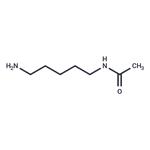N-(5-Aminopentyl)acetamide is an acetylated polyamine, a promising biochemical marker for cancer and many other pathophysiological conditions.
ChEBI: N-acetylcadaverine is an N-substituted cadaverine that is cadaverine in which one of the amino groups has been converted to the corresponding acetamide. It has a role as a human metabolite. It is a secondary carboxamide, a primary amino compound, a member of acetamides and a N-substituted cadaverine. It is functionally related to a cadaverine. It is a conjugate base of a N-acetylcadaverine(1+).
Monoacetylcadaverine is the acetylated form of the polyamine cadaverine.
Polyamine is a small organic polycation composed of a hydrocarbon backbone with multiple amino groups which ubiquitously exists in all living organisms from bacteria to higher animals. The critical step of polyamine biosynthesis generally includes the amino acid-decarboxylating reaction to produce the primary diamines, such as cadaverine from lysine. Synthesized polyamines are implicated in a wide variety of cytoplasmic reactions such as DNA replication and protein synthesis, and are essential for proper growth and proliferation of the organisms. Cadaverine is a linear molecule that terminate at both ends with an amine functional group. These functional groups confer to the multiple positive charges at physiological pH. Cadaverine is produced through the action of basic amino acid decarboxylases and is found associated with the outer membrane molecules.
| Human Endogenous Metabolite < span> |

